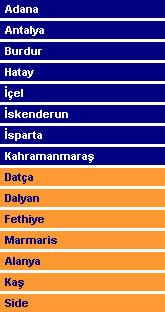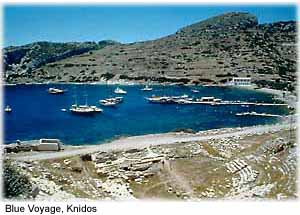| Datca... |
|
A narrow, mountainous finger of land points westward from Marmaris, stretching 100 km to touch the edge of the Aegean.
About 75 km west of Marmaris through pine forests lies the pleasant and relatively untouristed village of Datca. Another
35 km brings you to the hamlet and ruins of Knidos, the ancient city of the great sculptor Praxiteles. Leaving Marmaris
for the trip along the peninsula takes you up into the mountains. Not too long after leaving town you'll see a road on
the left marked for Bozburun, about 40 very bumpy km along. It's an idyllic spot, best reached by boat, where there's a
small hotel, restaurant and a "yacht club" with showers and laundry facilities for the yachters. Continuing along the
main road to Datca, at the 22-km mark is "Cabucak Dinlenme Yeri", a rest area, camping place and park operated by the
Directorate of Forests. There's also the small Firat Motel. After 70km you reach Resadiye, where a road goes off to the
left for Datca whfle the main road continues westward to Knidos. Datca is essentially a one-street town. The road into
Datca passes near the hospital, past the gendarmerie and through a commercial district of shops selling scented honey and
spices. Past several small teahouses and restaurants, you reach the main plaza with its marketplace and bus area. The
street then climbs a hill, curves to the left down the other side, scoots across an isthmus and ends on a hill at the end
of a short peninsula. This whole distance is about one km. At Knidos, 35 km west of Datca at the very tip of the peninsula,
are ruins of a prosperous port town dating from about 400 BC. The Dorians who founded it were smart: the winds change as
one rounds the peninsula and ships in ancient times often had to wait at Knidos for good winds. This happened to the ship
carrying St Paul to Rome for trial. Being rich, Knidos commissioned the great Praxiteles to make a large statue of
Aphrodite. It was housed in a circular temple in view of the sea. The statue, said to be the sculptor's masterpiece, has
been lost. Other than the ruins, Knidos consists of a tiny jandarma post with a telephone for emergencies, four little
makeshift restaurants (the Bora and the Knidos were most popular on my last visit), a repository for artefacts found on
the site (no entry), and the "Bora Pansiyon", which will put you up for US $ 4 per person in a room without running water
if space is available; or you can camp nearby and use the Bora's facilities for a small fee. You can swim in the bays from
wooden piers, but the beaches are several km out of town.
|
|

|






